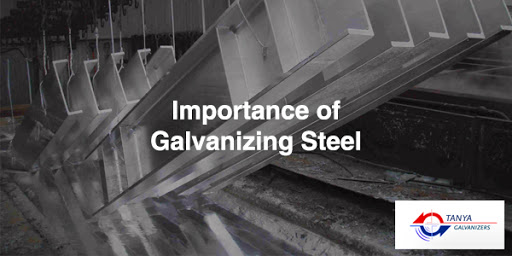Hot dip galvanizing is essential for industries that rely on steel and iron structures. It ensures durability, corrosion resistance, and long-term reliability, making it integral to construction, automotive, and industrial projects. If you’re looking for the best hot dip galvanizing plant in India, look no further than Tanya Galvanizers. Tanya Galvanizers has emerged as a trusted name in the industry because of their superior quality, advanced technology, and customer-focused approach.
What is Hot Dip Galvanizing?
Hot dip galvanizing is a process where steel or iron products are coated with a layer of zinc by immersing them in molten zinc at a temperature of around 450°C. This zinc coating provides a strong, protective barrier that shields the metal from corrosion caused by moisture, air, and other environmental factors.
The process involves multiple steps, including surface preparation, cleaning, and coating. The result is a durable, corrosion-resistant product that lasts decades, even in harsh conditions.
Why is Hot Dip Galvanizing Essential in India?
With its diverse climatic conditions and rapid industrial growth, India requires robust infrastructure and reliable materials. Steel and iron, commonly used in construction and manufacturing, are prone to rust and degradation when exposed to humidity, pollution, and varying temperatures.
Hot dip galvanizing addresses these challenges by:
- Providing Corrosion Resistance: The zinc layer prevents rust and extends the lifespan of steel and iron structures.
- Reducing Maintenance Costs: Galvanized products require little to no maintenance, saving time and money.
- Ensuring Durability: Galvanized materials can withstand harsh weather, making them ideal for use in coastal and industrial areas.
Tanya Galvanizers: The Best Hot Dip Galvanizing Plant in India
Tanya Galvanizers stands out as a leader in India’s hot dip galvanizing industry. Here’s why:
1. Advanced Technology and Infrastructure
Tanya Galvanizers employs state-of-the-art technology in its plants to ensure precision and efficiency in the galvanizing process. Their facilities have modern machinery that allows them to handle a wide range of products, from small components to large structural steel items.
2. Exceptional Quality Standards
Quality is the cornerstone of Tanya Galvanizers. They adhere to strict quality control measures at every stage of the galvanizing process, ensuring a uniform and durable zinc coating. Their commitment to quality has earned them customers’ trust across various industries.
3. Experienced Team of Experts
Tanya Galvanizers boasts a team of highly skilled professionals with years of experience in the galvanizing industry. From consultants to plant operators, their team ensures every project is executed flawlessly, meeting client expectations.
4. Comprehensive Range of Services
Tanya Galvanizers offers a variety of services, including:
- Consultation: Expert guidance to help clients choose the right galvanizing solutions for their specific needs.
- Custom Solutions: Tailored services to meet unique project requirements.
- Post-Galvanizing Support: Assistance with maintenance and quality checks to ensure long-term performance.
5. Environmentally Friendly Practices
Sustainability is a priority at Tanya Galvanizers. They use eco-friendly processes to minimize waste and reduce their carbon footprint. As a recyclable material, zinc aligns perfectly with their commitment to environmental responsibility.
6. Proven Track Record
With years of experience and numerous successful projects, Tanya Galvanizers has built a solid reputation in the industry. Their clients include some of the most prominent names in the construction, automotive, and manufacturing sectors.
Applications of Hot Dip Galvanizing
Hot dip galvanizing by Tanya Galvanizers finds applications in a wide range of industries:
- Construction: Roofing, structural steel, and bridges.
- Automotive: Car frames and chassis components.
- Agriculture: Irrigation systems, silos, and fencing.
- Energy: Solar panel mounts and wind turbines.
- Infrastructure: Utility poles, railway tracks, and highways.
Why Choose Tanya Galvanizers for Your Galvanizing Needs?
- Reliability: Tanya Galvanizers is known for delivering consistent results. Their products meet international standards, ensuring reliable performance in every application.
- Timely Delivery: With streamlined processes and efficient logistics, Tanya Galvanizers ensures that projects are completed on time, every time.
- Cost-Effectiveness: Their competitive pricing and the long-term savings of galvanized products make Tanya Galvanizers a cost-effective choice for clients.
- Customer-Centric Approach: Tanya Galvanizers values its customers and goes the extra mile to meet their needs. Their team is always ready to assist with queries and provide solutions that align with project goals.
What Our Customers Say About US:
Here’s what some satisfied customers have to say about Tanya Galvanizers:
- “Tanya Galvanizers provided exceptional service for our construction project. The quality of their galvanized steel was outstanding, and their team was extremely professional.”
- “We’ve been working with Tanya Galvanizers for years, and they have never let us down. Their attention to detail and commitment to quality are unmatched.”
Hot dip galvanizing is vital for ensuring the durability and reliability of steel and iron structures. In India, where diverse climatic conditions pose significant challenges, galvanizing is more critical than ever.
Tanya Galvanizers has established itself as India’s go-to hot dip galvanizing plant, offering top-quality services, advanced technology, and unmatched expertise. Whether in construction, automotive, or any other industry, Tanya Galvanizers is your trusted partner for all your galvanizing needs.








